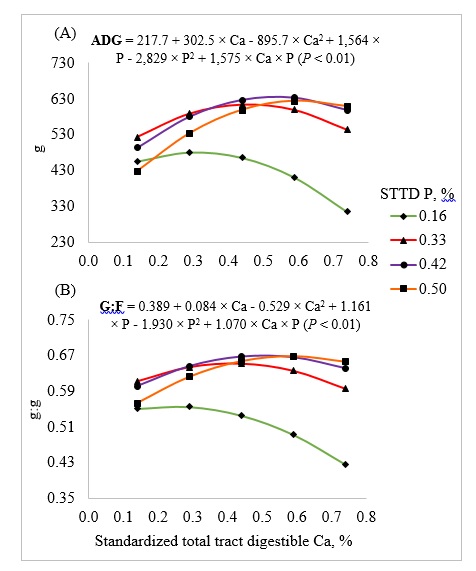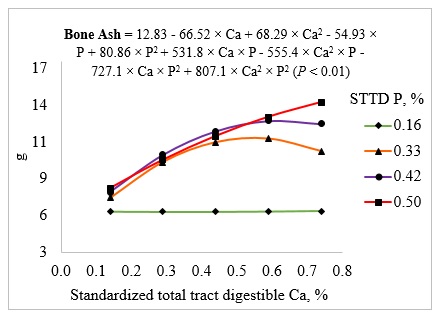Requirements for P for growing pigs are expressed as the requirement for standardized total tract digestible (STTD) P, whereas requirements for Ca are usually expressed as requirements for total Ca. It is, however, recognized that diets for pigs are most accurately formulated based on a STTD Ca:STTD P ratio, and recent work has generated values for STTD of Ca in most Ca containing feed ingredients, which makes it possible to formulate diets based on STTD Ca.
Recent data from the University of Illinois have indicated that if STTD P is at the requirement, a ratio between STTD Ca and STTD P that is less than 1.35:1, 1.25:1, and 1.10:1 maximizes growth performance of pigs from 25 to 50 kg, 50 to 85 kg, and 100 to 130 kg, respectively. However, the STTD Ca:STTD P ratio needed to maximize bone ash is greater than the ratio needed to maximize growth performance. An attempt to estimate the requirement for STTD Ca by pigs from 11 to 25 kg was also made, but due to a reduction in ADG and G:F as dietary Ca increased, an optimal STTD Ca:STTD P ratio could not be estimated.
Calcium may be absorbed by transcellular or paracellular transport. Transcellular transport is the primary route if dietary Ca is low, but if dietary Ca is adequate or high, Ca is mainly absorbed using the paracellular route via the tight junctions. However, there are limited data demonstrating effects of dietary Ca concentration on abundance of genes related to transcellular and paracellular transport of Ca in the small intestine of pigs.
Therefore, the objectives of this experiment were to test the hypotheses that a STTD Ca:STTD P ratio less than 1.40:1 maximizes growth performance of pigs from 11 to 25 kg and that increasing dietary Ca downregulates abundance of genes related to transcellular absorption of Ca and tight junction proteins in the small intestine.
Experimental design, diets, and statistical analysis
Six hundred and forty pigs with an initial average body weight (BW) of 11.1 ± 1.4 kg were randomly allotted to 20 diets and 5 blocks in a randomized complete bock design. There were 8 replicate pens per diet and 2 barrows and 2 gilts in each pen. Twenty corn-soybean meal-based diets were formulated using a 4 x 5 factorial design. Diets contained 0.16, 0.33, 0.42, or 0.50% STTD P, and 0.14, 0.29, 0.44, 0.59, and 0.74% STTD Ca. Data for growth performance, bone ash, and abundance of genes were analyzed using a second-order response surface model.
Results
Growth performance and bone mineralization
The model to predict ADG and G:F was reduced because only the interaction (P < 0.01) between STTD Ca and STTD P was significant (Fig. 1). The predicted maximum ADG and G:F at STTD P concentration of 0.33% was 614 g and 0.652 at STTD Ca concentrations of 0.46 and 0.41%, respectively, corresponding to STTD Ca:STTD P ratios of 1.39:1 and 1.25:1. Diets containing 0.33% STTD P are believed to be at the requirement for P.
The full model was used to predict the concentration of bone ash in g per femur (interactions, P < 0.01; Fig. 2). The predicted maximum bone ash at STTD P concentration of 0.33% was 11.68 g at a STTD Ca concentration of 0.55%, corresponding to a STTD Ca:STTD P ratio of 1.66:1.
Abundance of genes
Tested genes included S100 calcium binding protein G (S100G) and transient receptor potential cation channel, subfamily V, member 6 (TRPV6) for the duodenal tissue; and Occludin (OCLN), Zonula occludens-1 (ZO1), and Claudin-1 (CLDN1) for both duodenal tissue and ileal mucosa. Genes S100G and TRPV6 are related to transcellular absorption of Ca, whereas OCLN, ZO1, and CLDN1 are thigh junction genes related to paracellular absorption of Ca.
Neither Ca nor P could be used to predict the abundance of CLDN1 in the duodenum or the abundance of OCLN in the ileum. The model to predict the abundance of TRPV6, S100G, OCLN, and ZO1 in the duodenum and the abundance of CLDN and ZO1 in the ileum only contained the linear (P < 0.05) STTD Ca term, and for all genes, the slope of the prediction line was negative. This means that abundance of these genes is negatively affected by dietary Ca and increased dietary Ca, therefore, appear to reduce the transcellular absorption of Ca and increase the paracellular absorption.
Key points
- The STTD Ca:STTD P ratio needed to maximize growth performance of 11- to 25-kg pigs is around 1.35:1
- Maximizing bone ash requires a greater STTD Ca:STTD P ratio than maximizing growth performance.
- If dietary P is deficient or adequate, increasing dietary Ca reduces growth performance, but if P is above the requirement, the negative effect of excess dietary Ca is partly or fully ameliorated.
- Increasing dietary Ca reduces transcellular absorption of Ca and increases paracellular absorption of Ca.

Figure 1: Models and predicted values, based on the interaction between Ca and P (P < 0.01), for (A) average daily gain (ADG) and (B) gain to feed ratio (G:F) at d 21 in pigs fed diets containing from 0.14 to 0.74% standardized total tract digestible (STTD) Ca and from 0.16 to 0.50% STTD of P.

Figure 2. Models and predicted values, based on the interactions between Ca and P (P < 0.01), for bone ash in grams per femur (g) at d 21 in pigs fed diets containing from 0.14 to 0.74% standardized total tract digestible (STTD) Ca and from 0.16 to 0.50% STTD of P.